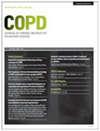慢性阻塞性肺疾病患者无脂量与运动试验结果之间的关系:一项系统综述
IF 2.1
4区 医学
Q3 RESPIRATORY SYSTEM
COPD: Journal of Chronic Obstructive Pulmonary Disease
Pub Date : 2022-04-12
DOI:10.1080/15412555.2022.2049737
引用次数: 3
摘要
慢性阻塞性肺疾病(COPD)患者往往具有异常低水平的无脂质量(FFM),其中包括骨骼肌质量作为中心组成部分。本系统综述的目的是综合COPD患者FFM与运动试验结果之间关联的现有证据。检索了MEDLINE、Cochrane Library、EMBASE、Web of Science和Scopus。评估COPD患者运动相关结果与FFM测量的研究被纳入。83项研究纳入了18,770名COPD参与者(39%为女性)。在评估FFM和运动测试结果的方式中发现了相当大的异质性;然而,高水平的FFM通常与更高的峰值运动能力相关。这种关联在某些运动测试结果(如增量循环运动测试中的峰值耗氧量)比其他结果(如6分钟步行距离)更强。本综述确定了测量FFM和运动能力的方法存在异质性。总体而言,慢性阻塞性肺病患者FFM与运动能力呈正相关。此外,还缺乏调查FFM与运动时的生理和知觉反应之间关系的研究。这篇综述强调了FFM作为COPD患者运动能力决定因素的重要性。本文的补充数据可在https://doi.org/10.1080/15412555.2022.2049737上在线获得。本文章由计算机程序翻译,如有差异,请以英文原文为准。
The Association between Fat-Free Mass and Exercise Test Outcomes in People with Chronic Obstructive Pulmonary Disease: A Systematic Review
Abstract People with chronic obstructive pulmonary disease (COPD) tend to have abnormally low levels of fat-free mass (FFM), which includes skeletal muscle mass as a central component. The purpose of this systematic review was to synthesise available evidence on the association between FFM and exercise test outcomes in COPD. MEDLINE, Cochrane Library, EMBASE, Web of Science, and Scopus were searched. Studies that evaluated exercise-related outcomes in relation to measures of FFM in COPD were included. Eighty-three studies, containing 18,770 (39% female) COPD participants, were included. Considerable heterogeneity was identified in the ways that FFM and exercise test outcomes were assessed; however, higher levels of FFM were generally associated with greater peak exercise capacity. This association was stronger for some exercise test outcomes (e.g. peak rate of oxygen consumption during incremental cycle exercise testing) than others (e.g. six-minute walking distance). This review identified heterogeneity in the methods used for measuring FFM and exercise capacity. There was, in general, a positive association between FFM and exercise capacity in COPD. There was also an identified lack of studies investigating associations between FFM and temporal physiological and perceptual responses to exercise. This review highlights the significance of FFM as a determinant of exercise capacity in COPD. Supplemental data for this article is available online at https://doi.org/10.1080/15412555.2022.2049737 .
求助全文
通过发布文献求助,成功后即可免费获取论文全文。
去求助
来源期刊

COPD: Journal of Chronic Obstructive Pulmonary Disease
RESPIRATORY SYSTEM-
CiteScore
4.40
自引率
0.00%
发文量
38
审稿时长
6-12 weeks
期刊介绍:
From pathophysiology and cell biology to pharmacology and psychosocial impact, COPD: Journal Of Chronic Obstructive Pulmonary Disease publishes a wide range of original research, reviews, case studies, and conference proceedings to promote advances in the pathophysiology, diagnosis, management, and control of lung and airway disease and inflammation - providing a unique forum for the discussion, design, and evaluation of more efficient and effective strategies in patient care.
 求助内容:
求助内容: 应助结果提醒方式:
应助结果提醒方式:


